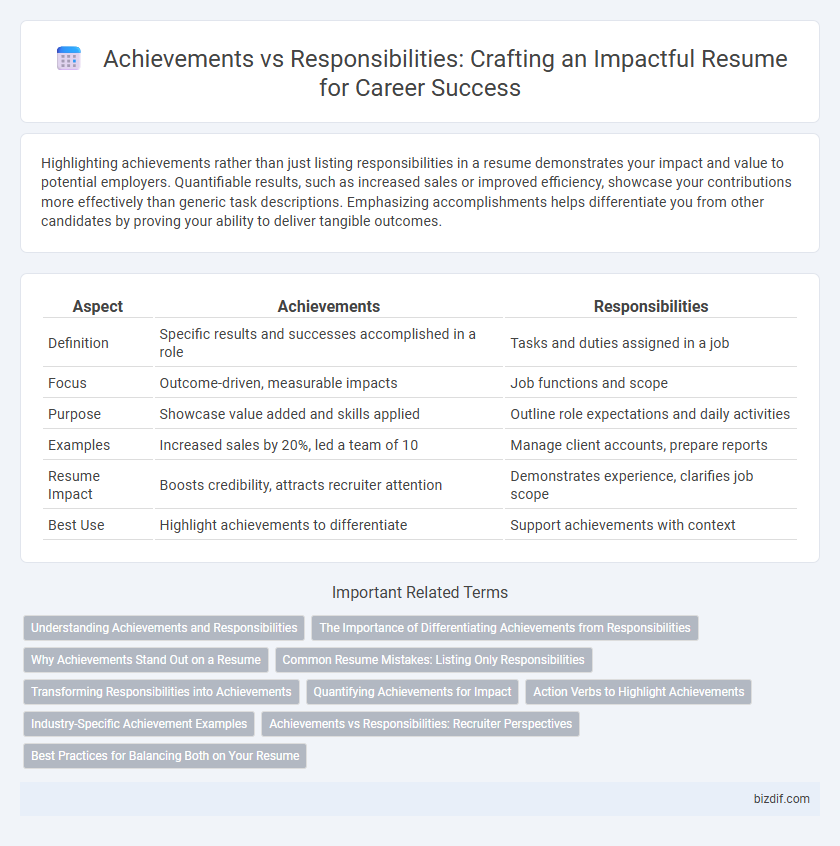Highlighting achievements rather than just listing responsibilities in a resume demonstrates your impact and value to potential employers. Quantifiable results, such as increased sales or improved efficiency, showcase your contributions more effectively than generic task descriptions. Emphasizing accomplishments helps differentiate you from other candidates by proving your ability to deliver tangible outcomes.
Table of Comparison
| Aspect | Achievements | Responsibilities |
|---|---|---|
| Definition | Specific results and successes accomplished in a role | Tasks and duties assigned in a job |
| Focus | Outcome-driven, measurable impacts | Job functions and scope |
| Purpose | Showcase value added and skills applied | Outline role expectations and daily activities |
| Examples | Increased sales by 20%, led a team of 10 | Manage client accounts, prepare reports |
| Resume Impact | Boosts credibility, attracts recruiter attention | Demonstrates experience, clarifies job scope |
| Best Use | Highlight achievements to differentiate | Support achievements with context |
Understanding Achievements and Responsibilities
Understanding achievements and responsibilities in resume writing is crucial for effectively showcasing professional value. Achievements highlight specific, quantifiable outcomes that demonstrate impact, while responsibilities describe routine tasks and duties performed in a role. Emphasizing achievements over responsibilities helps recruiters clearly see a candidate's contributions and potential for future success.
The Importance of Differentiating Achievements from Responsibilities
Highlighting achievements rather than just listing responsibilities in a resume significantly boosts its impact by showcasing measurable results and personal contributions. Employers prioritize candidates who demonstrate how their actions led to tangible improvements, such as increased sales, enhanced efficiency, or successful project completions. Differentiating achievements from responsibilities helps applicants stand out by providing concrete evidence of their value and effectiveness in previous roles.
Why Achievements Stand Out on a Resume
Achievements on a resume demonstrate measurable outcomes and tangible impact, showcasing a candidate's ability to deliver results beyond routine tasks. Unlike responsibilities that describe job duties, achievements highlight specific successes such as revenue growth, cost savings, or project completions. Hiring managers prioritize these results-driven accomplishments because they provide clear evidence of skills, effectiveness, and value to potential employers.
Common Resume Mistakes: Listing Only Responsibilities
Listing only responsibilities in a resume is a common mistake that limits the impact of job descriptions and fails to demonstrate real value to employers. Achievements showcase measurable results, such as increased sales by 20% or streamlined processes that saved 10 hours weekly, providing concrete evidence of skills and contributions. Highlighting accomplishments rather than just duties differentiates candidates and improves resume effectiveness in applicant tracking systems (ATS).
Transforming Responsibilities into Achievements
Transforming responsibilities into achievements on a resume highlights measurable impact and results, making candidates stand out to employers. Use action verbs and quantify outcomes, such as "increased sales by 20%" instead of simply listing tasks like "managed sales team." This approach demonstrates value and effectiveness, showcasing how past roles contributed to organizational success.
Quantifying Achievements for Impact
Quantifying achievements on a resume enhances impact by showcasing measurable results, such as increasing sales by 20% or reducing project delivery time by 15 days. Highlighting specific metrics demonstrates your value and differentiates you from candidates who only list responsibilities. Employers prioritize concrete accomplishments that illustrate your effectiveness and contribution to business goals.
Action Verbs to Highlight Achievements
Action verbs like "led," "implemented," and "accelerated" effectively highlight achievements by showcasing proactive contributions and measurable impacts. Emphasizing results-oriented language distinguishes accomplishments from routine responsibilities, increasing the resume's appeal to recruiters. Utilizing quantifiable metrics alongside action verbs enhances clarity and demonstrates tangible success in previous roles.
Industry-Specific Achievement Examples
Highlighting industry-specific achievements in a resume demonstrates proven expertise and measurable impact, such as increasing sales by 30% in retail or reducing project delivery time by 20% in construction. Specific accomplishments like securing multimillion-dollar contracts in finance or implementing cost-saving automation in manufacturing can set candidates apart from those listing generic responsibilities. Quantifying results with relevant metrics and tailoring examples to the target industry ensures a stronger, more persuasive resume.
Achievements vs Responsibilities: Recruiter Perspectives
Recruiters prioritize achievements over responsibilities because achievements demonstrate measurable impact, showcasing a candidate's ability to deliver results and add value to the company. Responsibilities outline job duties but do not distinguish candidates or highlight their unique contributions, making achievements more persuasive in resume screening. Quantifiable accomplishments such as increased sales percentages, project completions ahead of schedule, or cost savings provide concrete evidence of a candidate's effectiveness and potential.
Best Practices for Balancing Both on Your Resume
Highlighting measurable achievements alongside key responsibilities creates a compelling resume that demonstrates both capability and impact. Quantify successes with metrics such as percentage improvements, revenue growth, or project milestones to provide tangible evidence of your contributions. Balance detailed duty descriptions with specific results to showcase proactive problem-solving and value added to previous employers.
Achievements vs Responsibilities Infographic

 bizdif.com
bizdif.com